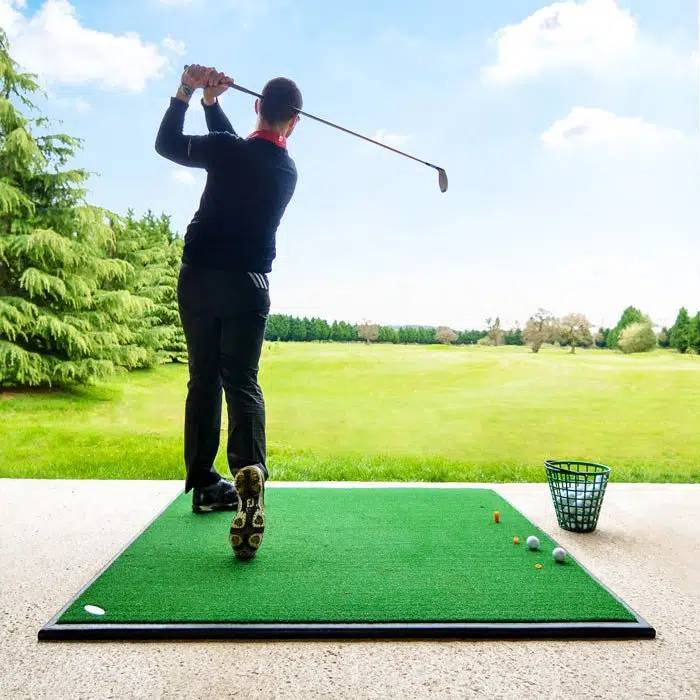Whether it’s hitting balls at the driving range or at home in your own backyard set-up, as a golfer you’ll often be required to practice your swing by hitting off a golf mat.
You’ve all seen them – they’re those green, felt-topped, rubber-based swing stations where golfers of all abilities, from high handicappers to low handicappers, can hit balls for hours without leaving any divots.
The advantages are you don’t get dirt or turf stuck in the grooves of your club, and you don’t need to repair the craters you’ve dug as a result of an hour-long range session.
But there is one possible disadvantage, and it has many players asking: Do golf mats damage your clubs?
Because of their firm surface, golf mats may scratch your golf clubs. This is a common complaint of many players. The golf club is unable to glide through the mat surface like it would on a grassy fairway, meaning your clubhead and shaft are susceptible to bending over time. This is more likely in clubs with soft blade heads or graphite shafts.
When it comes to practicing your swing, nothing beats hitting off real grass – and while a mat is a good substitute, it does increase the chance of you doing damage to your golf club.
There’s been many times where I’ve seen players hit shots at the range, only for their clubhead to fly off into the air after being dislodged due to repeated blows into the firm golf mats.
This is particularly common in clubs such as hybrids or fairway woods.
While it hasn’t happened to me personally, there is a higher likelihood of damaging your clubs when hitting off golf mats as opposed to real grass.
Keep reading to find out more about the pros and cons of using golf mats during your practice sessions.
Table of contents
What are golf mats made of?
Golf mats are most commonly constructed using a highly-durable nylon surface that has been woven together, which is then attached to the top of a thick, rubber base. Some mats use foam instead of rubber, and while this may be gentler on your golf club, they are less durable – meaning there’s a good chance the mat will need to be replaced much earlier than one with a rubber sole.
The woven artificial turf that covers your golf mat can also vary – some has longer fake grass to imitate more of a rough lie, while others have grass more closely resembling the kind of fairways you’d find at Augusta National.
The bigger the mat, the heavier it is and, consequently, the more stable it is – if you’ve ever tried to move one of the big mats at a driving range, you’ll know exactly what I mean.
Ideally, if you’re looking to purchase a driving mat for personal use in your own backyard or home, you want one big enough that allows you to stand on it while hitting your shot to ensure you’re hitting off a level surface.
The mat is less likely to move by doing this, also.
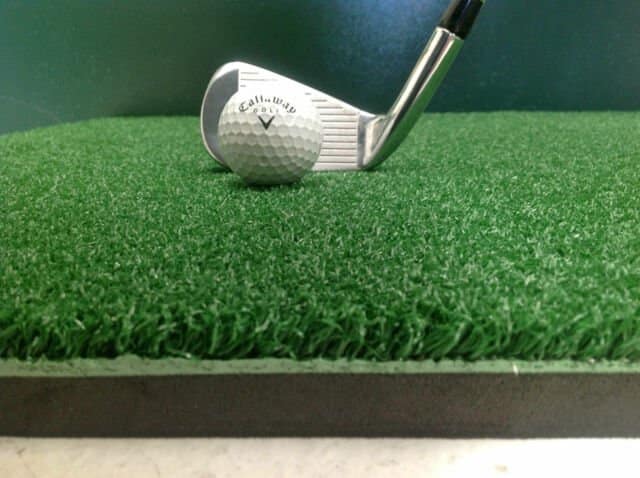
Are golf mats bad?
Golf mats have advantages and disadvantages: the pros include protecting the grass surface at driving ranges; providing a level, solid base to hit from; and ease of transportation. The cons include potential structural damage to your clubs over time; false feedback regarding quality of strike; and marking the sole of your club.
Despite the potential scratches they might leave on your golf club, mats are a tried and tested surface from which you can effectively practice your swing.
I’ve expanded on the pros and cons about hitting off golf mats below.
Pros of golf mats
- Provide a stable, consistent surface to strike the ball from
- Don’t require you to replace your divots after your practice sessions
- Are extremely durable and can last a long time
- Are portable, meaning they can be moved and allow you to practice in all weather conditions
- Are affordable for the average golfer
Cons of golf mats
- May cause damage to your clubs over time
- Sometimes provide ‘false’ feedback about the quality of your strike
- Can sometimes leave a thin, green turf mark on the sole of your club
- Are more forgiving to hit off than real turf, which can mask swing flaws
If I was to single out the biggest flaw of golf mats, it’s that they can definitely trick you into thinking you’re striking the ball better than you actually are.
Because of the mat’s firm surface, shots that would normally be ‘fat’ or ‘heavy’ out on the golf course – due to you striking the ground behind the golf ball – still fly okay because the mat bounces the clubhead back up and into the ball.
This gives you false feedback about the quality of connection between club and ball, and may give the illusion you’re compressing it correctly when you actually may not be.
It’s why many people complain they had a great range session earlier in the week, but come the weekend, when they’re out on the course, they can’t understand why they’re hitting everything fat.
There’s a reason why most professional players are always spotted hitting off real turf, as opposed to artificial mats. They feel completely different.
But there are ways to make sure you’re striking the ball well when hitting off a golf mat, ensuring your practice session is worthwhile, and we’ve explained it in another article here.
Hitting irons off golf mats: should you do it?
Yes, absolutely! I’ve been hitting off golf mats for years, and while my clubs have gotten a little scratched over the journey it has been worth it because my golf swing has improved dramatically. The positives of hitting off golf mats far outweigh the negatives.
But there are some things you can do to ensure you’re getting the absolute most out of your practice when using irons on a golf mat.
The first is to pay attention to the sound of your ball-striking.
If you hear a big ‘thud’ every time your club strikes the ball, chances are your angle of attack is far too steep and there’s an even greater chance that had you hit the shot on the golf course, it would’ve been fat.
You should listen for a lighter, ‘skimming’ sound which will indicate you’re hitting with a shallower angle of attack, which will confirm you’re likely connecting with the ball first, and the mat second – which is exactly what we want.
Some other ways to get feedback on the quality of your ball striking, as we explained in more depth in another article, is as followed:
Monitor your distances
This is a great way to determine if you’re striking the ball or the mat first. If you normally hit your 6-iron 160 metres and find yourself hitting it only 120m at the range, it’s a clear indication that you’re making a poor connection with the golf ball. If your local range doesn’t have distance markers, consider investing in a rangefinder (we’ve recommended one here).
Place a strip of masking tape behind the ball
This is a great visual indicator of whether you’re hitting behind the ball or not. All you need to do is stick some masking tape (this brand from Amazon will do the trick) about an inch behind the golf ball. After you’ve taken your swing, look down and see if you’ve disturbed the tape or not – if you have, you know you’ve hit it fat. Laying down a golf towel (such as this cheap one) behind the ball is another way to do this.
Hitting wedges off golf mats: should you do it?
Yes, of course! But you should know – it’s far, far easier hitting wedges off golf mats than on the course. Even more so than irons. Because wedges tend to have sharper leading edges on the club face, if you hit them only slightly behind the ball on the golf course it will severely impact the quality of strike. Mats, however, are much more forgiving.
Similarly, wedges have more bounce than all other clubs in your bag – as a result, when you hit behind the ball on a golf mat using a wedge, the firm surface will bounce it into the back of the ball and still lead to a decent ball flight and distance (even though on the course it would’ve travelled nowhere).
Following those tips mentioned above is crucial when practicing your wedge play on golf mats, to ensure you’re getting the proper feedback about the quality of your strike.
How do I get the green mat off my golf clubs?
If you’ve spent lots of time hitting off golf mats like I have, you’ll have noticed that sometimes the sole of your club can end up covered in a thin, green layer of artificial turf that has detached itself from the mat due to repeated strikes.
Sometimes, this can be a real pain to remove.
I’ve found that using a wire golf brush such as the XinTan Tiger Golf Club Brush Groove Cleaner – the same brush I use to clean the grooves of my clubs during a round out on the course – and some warm water, plus a little bit of effort when scrubbing, works fine to remove the green layer.
Trust me, it’s worth the purchase.
What is the best golf hitting mat?
There are so many golf mats available online, some far more expensive than others, that it can sometimes be hard to know where to start.
But there are a few non-negotiables that I highly recommend you should take into account when beginning your search.
They are:
- The mat should comprise a dense, thick sole – preferably rubber
- The mat should be big enough so you can stand on it while swinging
- The mat shouldn’t blow your bank balance by being too expensive
When factoring in these three non-negotiables, I was really able to hone my search on Amazon to find the best three options available in their price range.
My top picks
SkyLife Golf Practice Mat
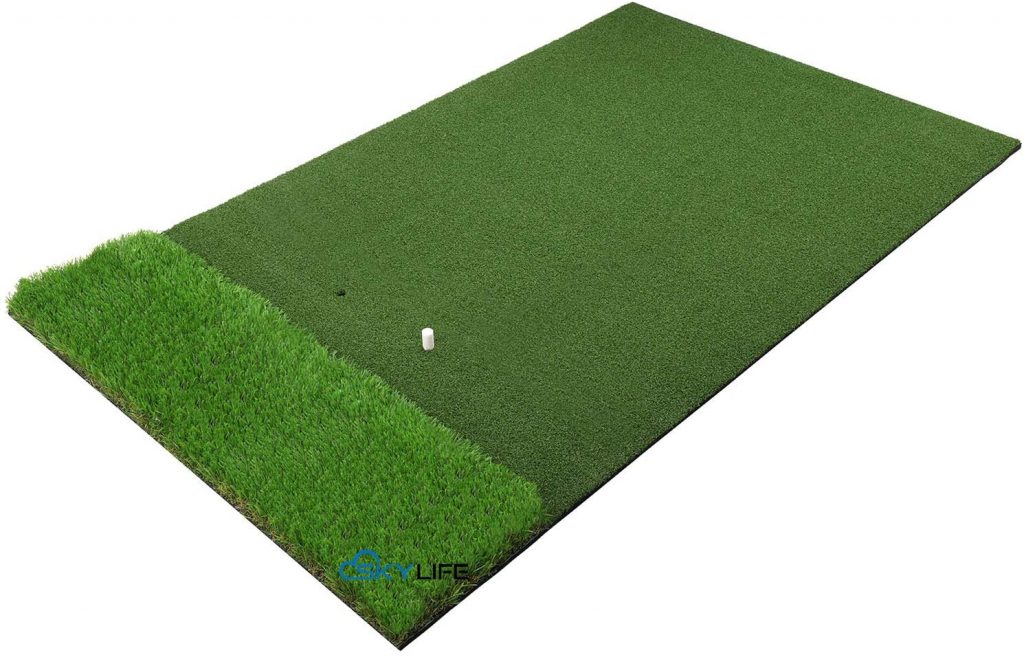
The SkyLife Golf Practice Mat is the most top-end golf mat I could find online.
It has a durable rubber base to ensure longevity, and is equipped with a different cut of artificial grass to mimic the first cut of rough you’d find when narrowly missing the fairway.
The mat is 3′ x 5′ wide meaning you can stand on it while swinging, which is ideal as it creates a level surface to practice on.
It also comes with the added bonus of 12 complimentary plastic practice balls and two rubber tee holders for your drivers and fairway woods.
It’s slightly pricier than other mats on the market, but is the gold standard if you want different types of turf included.
SharperGolf 3’ x 5’ Premium Quality Golf Practice Mat
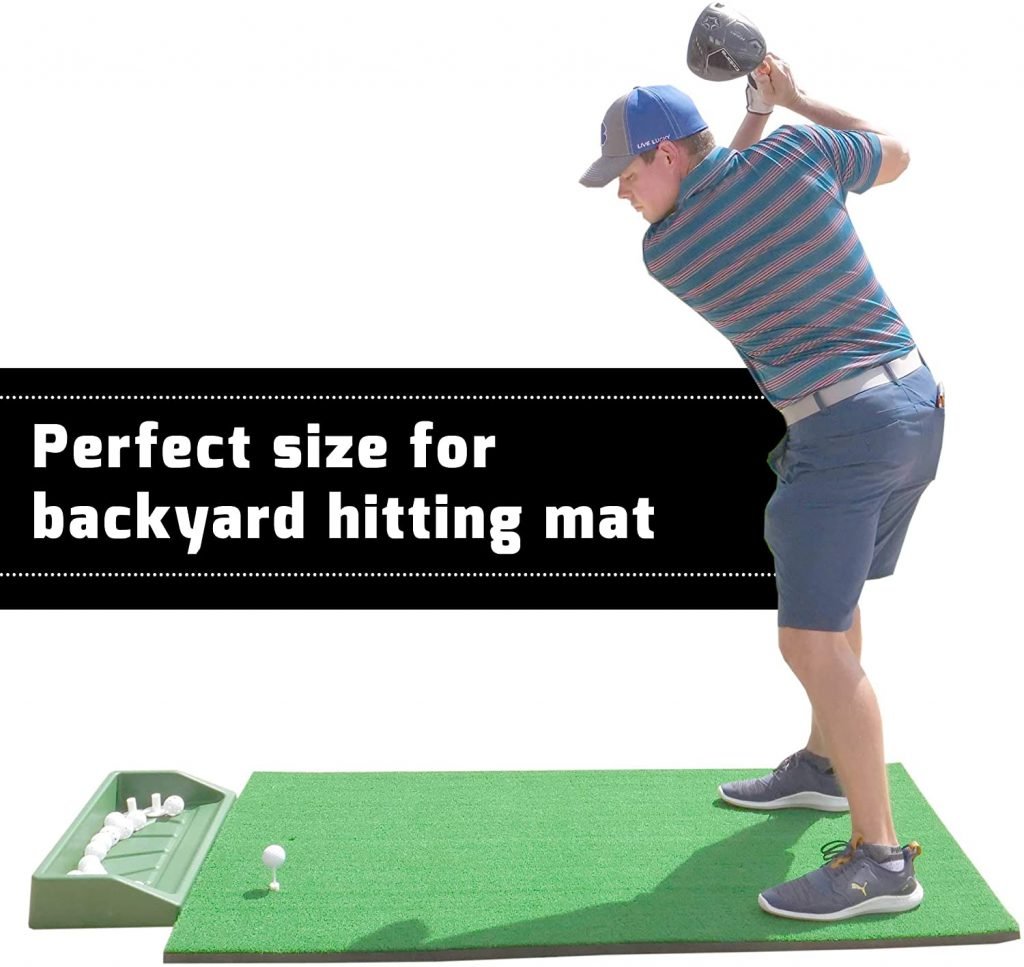
This mat is a great alternative if you’re looking for something more affordable – without sacrificing much on quality.
At 0.9m x 1.5m in size, the SharperGolf mat is big enough that you can stand on it while swinging, which ticks one of my non-negotiables listed above.
While the base is made of foam and not rubber, the fact it is almost 20mm thick gives me more comfort regarding its durability.
It also comes with the added extras of a full-sized commercial ball tray and four different tee hole locations, which adds extra value to your purchase.
If you don’t want to spend more than $300 on a mat, this is the best you’ll find.
Champkey Pro Golf Hitting Mat
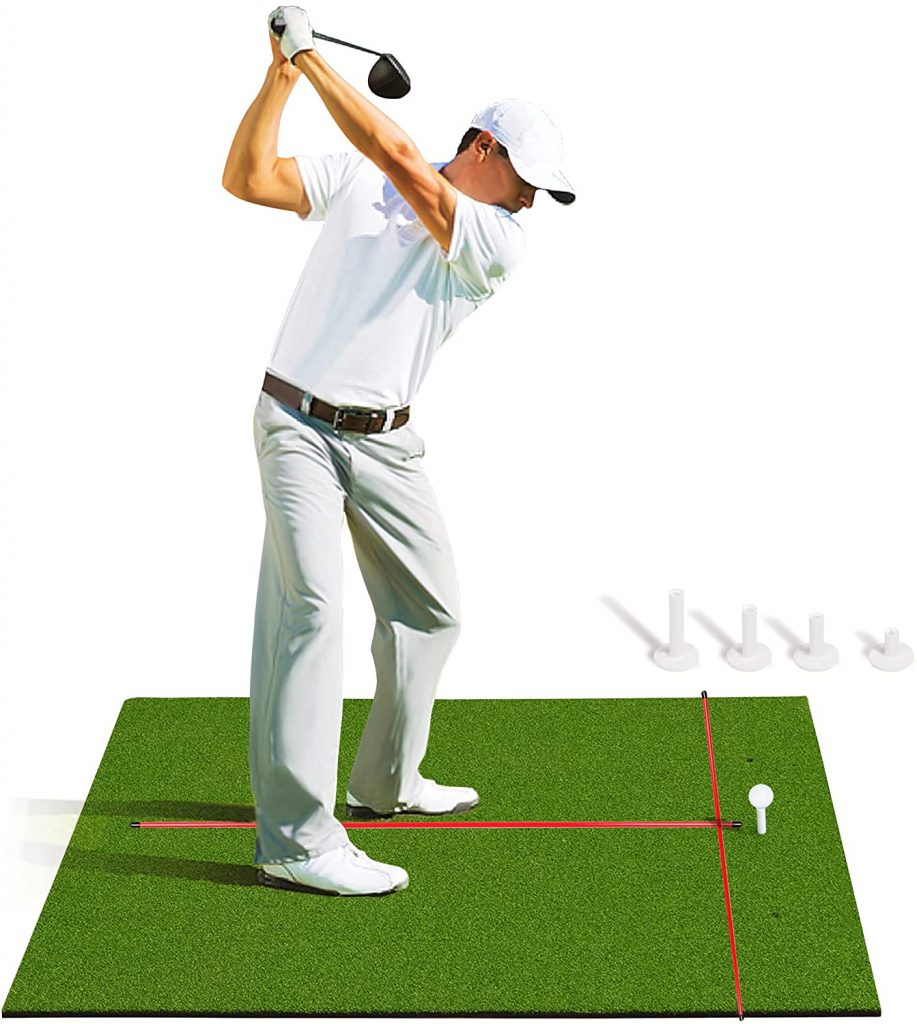
In terms of lower-tier golf mats, the Champkey Pro Golf Hitting Mat is the standout I could find on Amazon.
The mat comes in two different sizes – 0.9m x 1.5m and 0.9m x 1.2m – meaning it’s plenty big enough to allow you to stand on it while swinging.
The base is made of 8mm-thick rubber foam, which does make me question its durability somewhat.
In the end, if you’re going to skimp on price, naturally you can expect the quality to drop too.
But if you’re looking for a modestly-priced golf mat to get you started, this one should do the job – you just may find yourself replacing it earlier than some of the more top-end offerings.
- TaylorMade SIM2 Max Driver vs M4 Driver: Worth it in 2024? - April 15, 2024
- 3 Ways to Win the Mental Game with the Bridgestone Mindset Golf Ball - March 29, 2024
- TaylorMade SIM Max & SIM2 Max Drivers: Are they Still Relevant in 2024? - March 9, 2024

